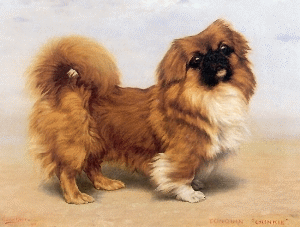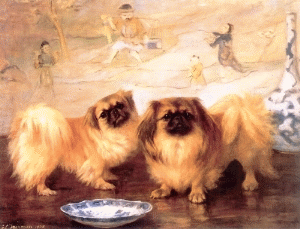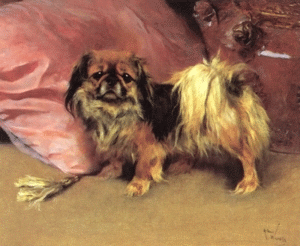|
|



|
About The Pekingese
Description
The Pekingese has an extravagant, long, straight-flowing coat that has profuse feathering and comes in all colors. It has a broad head that is wide between their large, dark, lucid and slightly prominent eyes. The face is flat with a dark, wrinkled muzzle, and drooping heart-shaped, long feathering ears. Their necks are short and thick. When their mouth is closed, neither teeth nor tongue should show. These tiny, heavy boned dogs have a characteristic rolling gait.
Temperament
Pekingese make devoted and good natured family members. They're good with children, although they may be regarded as not playful enough. Not recommended for young children who are too rough. Pekingese are bold, courageous, and sometimes self-important dogs. They're independent and often stubborn, which can make them a challenge to train. Reward-based training involving food goes a long way to keeping your Pekingese engaged, but be careful not to reward too much. If overfed, your Pekingese will quickly become overweight.
Height, Weight
Height: 6-9 inches (30.4-45 cm), Weight: 8-10 pounds (3.6-4.5 kg)
Any Pekingese under 6 pounds is called a sleeve Pekingese. It is the smallest member of the Pekingese family, and the most popular size during the breed's development in China. To be a sleeve it must be 6 pounds (2.7 kg) or under, anything over that is not a considered a sleeve. In between 6 and 8 (2.7-3.6 kg) pounds is considered a Mini Pekingese.
Health Problems
Pekingese tend to catch colds very easily. Very difficult births. Prone to herniated disks and dislocated kneecaps. Trichaiasis (lashes growing inwards toward the eyeballs). Breathing problems and heart problems are also common.
Living Conditions
The Pekingese are good for apartment life. They are relatively inactive indoors and will do okay without a yard.
Exercise
Pekingese need a daily walk. Play will take care of a lot of their exercise needs, however, as with all breeds, play will not fulfill their primal instinct to walk. Dogs that do not get to go on daily walks are more likely to display behavior problems. They will also enjoy a good romp in a safe open area off lead, such as a large fenced in yard. Get your Peke accustomed to the leash when they are still a puppy. Some owners have told me their Peke will walk up to 4 miles on a nightly walk.
Life Expectancy
With healthy dogs, about 13-15 years.
Grooming
Daily combing and brushing of the very long, double coat is essential. Take extra care around the hindquarters, which can become solid and matted. Females shed the undercoat when in season. Dry shampoo regularly. Clean the face and eyes daily and check the hairy feet for burrs and objects that stick there. These dogs are average shedders.
Origin
Pekingese where regarded as manifestation of the legendary Foo Dog that drove away spirits. They were venerated as semi-divine by the Chinese. Commoners had to bow to them; you were punished by death if you stole one, and when an emperor died, his Pekingese were sacrificed so that they could go with him to give protection in the afterlife. In 1860 the Pekingese reached the West. British and French troops over ran the Summer Palace during the Second Opium War. Imperial Guards were ordered to kill the little dogs to prevent them from falling into the hands of the "foreign devils," but five Pekingese survived and were taken to Queen Victoria, who named it appropriately, "Looty." It is from these canine spoils of war that the modern Pekingese is descended. In 1893 the breed was first shown in Britain. It was recognized in the US in 1909.
A remote British museum reveals enlightening clues to Pekingese origins.
Read this fascinating article, The Pekingese and The Happa Dog
written by Tony Rosato. Article first published in 1998.
|
|
